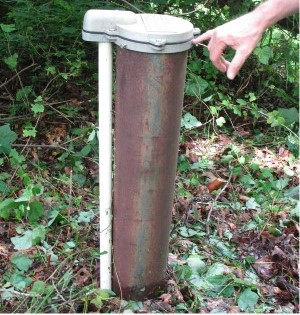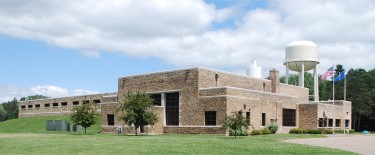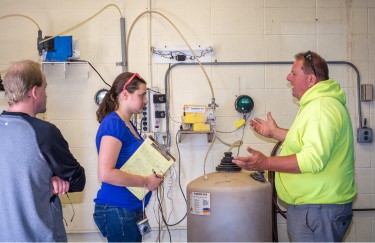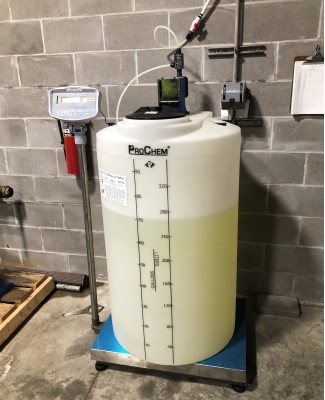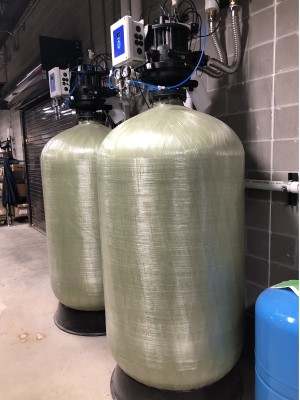Non-Transient Non-Community Public Water System Sanitary Survey
A sanitary survey is an evaluation of a water system's facilities, operations and records to ensure the delivery of safe and reliable water for human consumption. In Wisconsin, the DNR conducts routine sanitary surveys of non-transient non-community (NN) water systems every five years. A NN public water system is a water system that regularly serves at least 25 of the same people over six months of the year. There is no charge for a sanitary survey completed by DNR staff.
The Environmental Protection Agency (EPA) established the Safe Drinking Water Act in 1974 to protect the quality of drinking water in the U.S. The DNR ensures drinking water in the state of Wisconsin follows the regulations provided in the Safe Drinking Water Act. Sanitary surveys are one of the criteria to meet the regulations of the EPA and the DNR.
Purpose
Sanitary survey purpose
A routine sanitary survey is a five-year evaluation of water system facilities, operations and records used to identify conditions that may present a sanitary or public health risk. A sanitary survey may also be needed if a new well, new treatment system or any water system modifications are done. Proper operation and maintenance of your water system are essential for providing safe water to your consumers. The DNR's Drinking Water and Groundwater Program manages activities that affect the safety, quality and availability of drinking water to protect public health and water resources.
The sanitary survey is also an opportunity to discuss your water system with your DNR representative, ask questions, learn new strategies to optimize your system and identify potential problems before they lead to a public health risk. DNR representatives are a great resource for technical assistance, so don't hesitate to ask them questions or talk through options.
Process
Sanitary survey process
Your DNR representative will contact a representative (for example the owner, operator or sampler) of your water system to schedule a convenient time for the survey. Typically, sanitary surveys are scheduled one to two weeks from the contact date. Depending on the size of your water system, the sanitary survey may take anywhere from ½ hour to several hours. The department recommends reviewing the Non-Transient Non-Community Sanitary Survey Fact Sheet in advance, so you are familiar with all survey elements. Reviewing information and organizing records ahead of time will help ensure a time-efficient and successful sanitary survey.
Your DNR representative will evaluate the physical construction, operation and maintenance of the entire water system during the sanitary survey. They will need to visit all wells on the property, pressure system equipment, treatment systems and distribution faucets used for sampling. Be prepared to access these locations (for example, bring keys for locks that need to be opened to fully observe all applicable water system components; clean up the area; make sure water system components are accessible.) Be prepared if you may also need to navigate snow, rain and cold temperatures. During the survey, your DNR representative will review past water quality data with you and may discuss any noticeable trends in the data. The monitoring site plan for your system will be reviewed and updated if needed.
At the end of the survey, your DNR representative will summarize the sanitary survey results. This will include a discussion to develop a plan and timetable for correcting any noted deficiencies. You will be sent a sanitary survey report with a summary and any noted deficiencies within 30 days of the sanitary survey.
Survey preparation
Non-Transient Non-Community survey preparation
Sanitary surveys evaluate the adequacy of the water source and examine the facilities, equipment, operation, maintenance, monitoring, record keeping and any required public noticing. After the sanitary survey, you will receive a report with a summary of the inspection and an outline of any needed corrective actions that describe what needs to be done and due dates where applicable.
Review the prior sanitary survey report to identify any previously identified deficiencies. The department representative will verify the correction of previously identified deficiencies, so compiling documentation of when and how prior deficiencies were corrected will be helpful. If you can’t find a copy of the previous sanitary survey report, ask your DNR representative to provide you with a copy. Other records may be asked for during the survey, including plan approvals, treatment system operating reports or any enforcement documentation. Please have all water system records available for the sanitary survey as your DNR representative may ask to review them.
Thoroughly preparing for a sanitary survey may also help you identify and correct any aspects of your water system that are not currently in compliance ahead of time. If you are not able to complete the correction before the sanitary survey, be prepared to communicate your plan to return to compliance and a proposed timeline.
For more information on how to prepare for your sanitary survey, see the Top Common Problems Found During an NN Sanitary Survey Fact Sheet.
The eight elements of a sanitary survey for NNs
At a minimum, a routine sanitary survey will address the following eight focus areas:
Source
Your well(s) - make sure they are accessible for the sanitary survey.
Treatment
Any chemical or physical treatment for the water system. Examples include chlorine injection, water softeners and sediment filters.
Distribution system
Water system piping and any taps where water can be used for consumption.
Finished water storage
Includes pressure tanks, storage tanks or reservoirs.
Pumps, pumping facilities, controls
Includes any well house, pump(s) and pump controls.
Monitoring and reporting
Includes monitoring site plans and any potential water quality issues.
Water system management and operations
Technical, managerial and financial capacity to operate a water system.
Operator certification
Having a certified operator on staff or on contract to assist with the monitoring of the water system
Survey results
Understanding survey results
Take note of deficiencies during the sanitary survey. Deficiencies observed during the sanitary survey will be discussed and summarized at the end of the survey. Your DNR representative will discuss creating a plan and timetable for correcting any deficiencies. Please be sure to contact your DNR representative if you have questions about the survey report. Be sure to keep sanitary survey reports for future reference. View commonly found deficiencies in non-transient non-community systems.
The following definitions explain terms that may be found in a sanitary survey report:
Significant deficiencies
Significant deficiencies are defined in section NR 809.04(76), Wis. Adm. Code as defects or failures with the water system that pose a health risk to consumers. This could include:
- defects in the design, operation or maintenance of a public water system;
- a failure, malfunction or issue with the water sources or the treatment, storage or distribution system of a public water system that results in contaminated drinking water and consumer health risks;
- failure to post, distribute or submit a Tier 1 public notice (PN); or
- any past deficiencies that have not been corrected since the last sanitary survey.
Deficiencies
Deficiencies are problems in a public water system that can potentially cause serious health risks or represent long-term health risks to consumers. These deficiencies may indicate noncompliance with one or more Wisconsin Administrative Codes. Examples could include:
- poor water system maintenance;
- backflow prevention not provided on threaded faucet(s); or
- failure to post or distribute as well as submit a Tier 2 or Tier 3 public notice (PN).
Recommendations
Recommendations are designed to address problems in the water system that may prevent it from consistently providing safe drinking water to consumers. Recommendations may include:
- developing an emergency contact list;
- providing dehumidification to reduce rusting of your well casing, pressure tank, etc.;
- obtain a secondary (back-up) water system operator;
- addressing water quality concerns (increasing trend of contaminant(s), and/or plumbing changes, and/or hard water deposits, etc.).
Non-conforming features
These are system features that met code requirements at the time of a drinking water system's construction but do not meet current code. These are not considered deficiencies; however, they will need to be corrected in the future when the system completes any major upgrades. For example:
- an overlapping well cap installed prior to 1991;
- well terminates less than 12 inches above ground but met the minimum required height when constructed; or
- the well does not meet special well casing area requirements that went into effect after the well was constructed.
Codes
Wisconsin sanitary survey statutes, administrative codes and acts
- Safe Drinking Water: Section NR 809, Wis. Adm. Code
- Requirements for the Operation and Maintenance of Public Water Systems: ch. NR 810, Wis. Adm. Code
- Well Construction and Pump Installation: ch. NR 812, Wis. Adm. Code
- Certification Requirements for Waterworks, Wastewater Treatment Plant, Septage Servicing and Water System Operators: ch. NR 114, Wis. Adm. Code
- Well Drilling, Heat Exchange Drilling and Pump Installing: ch. 280, Wis. Stats
- Water and Sewage: ch. 281, Wis. Stats
Helpful Links
Helpful Links
- NN Sanitary Survey Fact Sheet
- Public water system owners and operators
- Public Drinking Water System (DWS) Data Viewer
- DWS Viewer Instructions
- DNR Switchboard for EMOR access
- Wisconsin Department of Health Services (DHS) drinking water page
- Drinking water publications
- Common Issues Found During a NN Sanitary Survey
- Emergency Operations Plan Example
- DSPS Water Treatment approval request (click on Plumbing Products drop down list, required information for approval of water treatment devices)
Technical Assistance Resources:
- Wisconsin Water Well Association
- Wisconsin Rural Water Association
- List of well drillers
- List of pump installers
Operator Certification Resources:
Frequent water system deficiencies from Wateroperator.org:
Contact information
For information about requirements for your drinking water system, contact your department representative or the DNR public drinking water representative assigned to your county:
Gov Delivery
The DNR uses GovDelivery to distribute information to help the agency more efficiently manage digital communications and offer more subscription options to customers. Sign up for GovDelivery.

